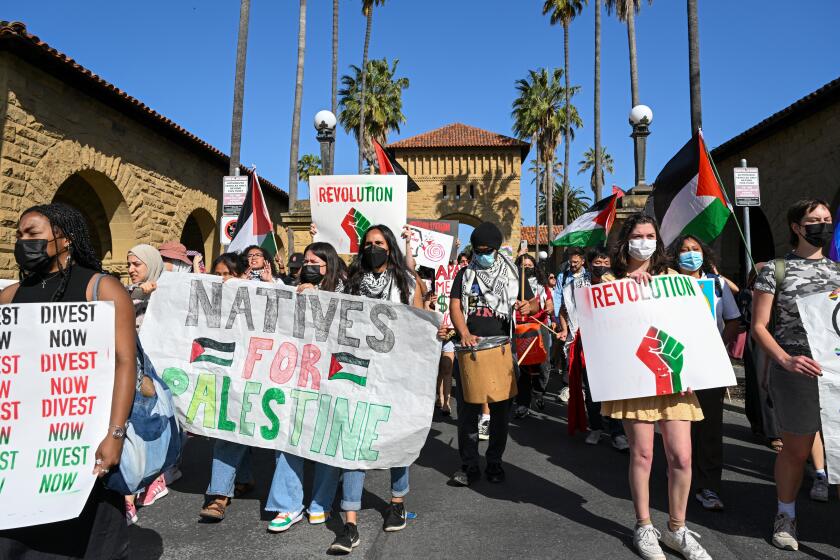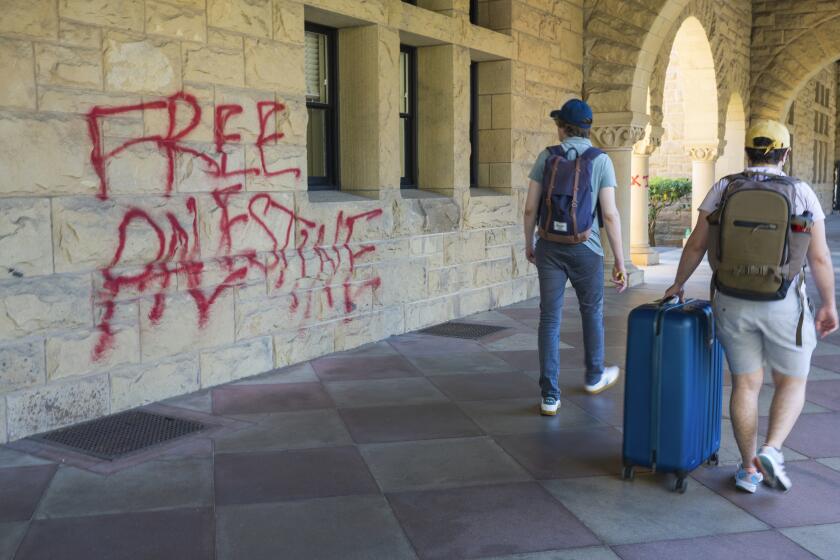MacArthur Park--Art Helps Paint a New Image : School Project, Including Year-Old Mural, Seen as a Catalyst for Troubled Community
- Share via
John Terui, maintenance supervisor for MacArthur Park, paused in the middle of a conversation about graffiti. Nearly every bench and wall he could see at the downtown park was filled with it, as if he hadn’t been painting it out just the day before.
But there was one area that remained graffiti-free, Terui said, pointing at the park’s bandstand. A giant mural in bright red, blue and hot pink covered the back, a melange of faces, words, dragons, palm trees and even an RTD bus.
“Since they put that up,” he said, “the people that used to graffiti that wall all the time, they don’t.”
The mural was placed there last summer by a multi-ethnic group of local teen-agers, some of them painting only with spray cans. It is part of a project started a year ago by Otis Art Institute of Parsons School of Design, which borders the park, to reverse the area’s decline--through art.
Rallying Point, Catalyst
Instead of simply beautifying the park, however, the program is putting this art to an unusual use, and its sponsors believe it may well be the first of its kind. The art is designed to be a rallying point to revive interest and caring about the park, and as a catalyst for improving the surrounding community, too.
That the mural has remained graffiti-free is perhaps a small signal that the idea may work, said Art Nodal, exhibitions director at Otis/Parsons and head of the MacArthur Park public art program.
Besides the mural, only two of the eventual 10 art works have been placed in the 32-acre park over the last year. But the program already seems to have sparked other community activities, most importantly the formation early this year of a community council composed of merchants, civic groups, residents and government representatives.
“There’s never been any true organization before in that community,” said Tom Lobange, deputy to City Councilman John Ferraro, who represents the area.
The community council’s activities have in turn led to an adopt-a-trash-can program among local businessmen to fight littering, the formation of neighborhood watch programs to fight crime and even a “First Annual MacArthur Park Three-Kilometer Run,” which was held in the park three weeks ago.
Art Deco Archways
The start and finish points for the run were two new Art-Deco-style pedestrian archways created by an Otis/Parsons artist and set up a month ago.
According to council Chairman Gene Baur, owner of the ornate 60-year-old Park Plaza Hotel, which borders the park, “The art in the park has been like an anchor . . . to reverse the negative image.”
“This is by no means a cure-all,” Ferraro said, “but it’s a start.”
“Nothing by itself means anything,” said Frank Patchett, captain of the Los Angeles Police Department’s Rampart Division, which patrols the area. “You put it all together, it has meaning.”
Two miles from City Hall, the park is at the center of Westlake, a formerly middle-class neighborhood that has taken a slide. Almost 30% of the residents under 55 live in poverty, 70% call themselves Hispanic--many newly arrived from Central America--and the mean household income is below that of South-Central Los Angeles.
As downtown has increasingly been redeveloped, a number of homeless or unemployed people have migrated westward into the neighborhood. By the early 1980s, the once-elegant park--reclaimed from marshland a century ago and known for its statues, green lawns and scenic lake--had earned a reputation for violence, and particularly as a nighttime domain for drug peddlers.
Grim Statistics
In the last 3 1/2 years, according to police statistics, the immediate park area has been the site of 385 street robberies, 297 assaults, 41 rapes and 11 murders.
Many community people simply stopped going there.
“I used to walk it every morning and look at the birds,” Rita Patens, a 66-year-old retired accountant, said recently, adding, “I don’t anymore.”
Rene Brizuela, executive director at the YMCA bordering the park, said, “I used to run in the park, but I stopped, around 1981.”
Nodal, originally an artist himself who directed the Project for the Arts in Washington, came to Otis/Parsons in 1983. His previous job had given him experience in placing art in public places, he said.
“I was hired to run the gallery,” he said, “but I took the job because of the park.”
His Vision Described
One recent afternoon, Nodal, 35, walked through the park, energetically describing his vision, which occupies almost all of his waking hours.
“I saw the beauty of it, and the potential between that kind of a setting, that kind of urban amenity and our institution. It was a wonderful combination.”
Nodal felt the key to the program’s success would be community involvement.
“We realized we had to get the community involved,” he said. “If not, it wouldn’t work.”
Before launching the project, which has attracted $187,000 through federal and city grants and corporate donations, Nodal met with local businessmen such as Baur, Ferraro and representatives of the city Recreation and Parks Department.
“We were very excited about their ideas,” Sheldon N. Jensen, the department’s assistant general manager, said.
No One Had Done This
No one had ever approached the department with such an idea, he added.
“We’ve had people come in and ask to put art in the parks. That happens a lot. But we’ve never had somebody say, ‘I’d like to construct art works and want the people to be involved,’ ” he said, adding that he wanted to avoid what he calls “plop art, where a piece of art gets plopped down with no relationship to its surrounding area.”
Therefore, the 11 artists, seven of whom are locally based, were required to spend a two-week period walking through the park and meeting with community representatives before they decided what they would contribute.
The resulting work, Nodal said, “in a sense is functional art. It functions according to the issues of the neighborhood.”
Artist Alexis Smith of Los Angeles, for example, noticed that the giant neon signs above the neighboring theaters and hotels had deteriorated, and undertook to renovate them. Nodal said the signs would be relit in December “as a Christmas present to the neighborhood.”
Sculpture for Children
Another Los Angeles artist, Judith Simonian, saw the large number of children who frequent the playground and decided on a sculpture that children could play with. The result was two mini-pyramids, child-sized and easy to climb. Set 30 yards apart, they are connected by a sound tube so that children on one can talk to their playmates on the other. They were installed two weeks ago.
Under construction in the park’s northwest corner is a poetry garden, where two artists are putting up benches and chairs fitted with speakers that will play Central American verse.
Lighting a Problem
Because poor lighting is a park problem, some of the artworks will incorporate lighting, Nodal added. The band-shell mural was what he described as a spin-off because the council had expressed concern about the graffiti problem. If its graffiti-free facade is a positive result, so too was the 3-kilometer run, organized by Brizuela, whose staff had also stopped running there.
“We wanted to encourage people going back in there, and to help Al’s program,” Brizuela said. Local merchants donated prizes, he added, and about 40 runners showed up.
One runner was Margaret Sturgeon, 77, a retired minister who has lived in the area most of her life.
“It was the first time I’d been in there in 10 years. I wondered about going. I sat in meditation about three nights before I decided it would be safe. I enjoyed the participation in it,” she said, sounding surprised. “If they had it again I would do it. I wish they had more things.”
More to Read
The biggest entertainment stories
Get our big stories about Hollywood, film, television, music, arts, culture and more right in your inbox as soon as they publish.
You may occasionally receive promotional content from the Los Angeles Times.










